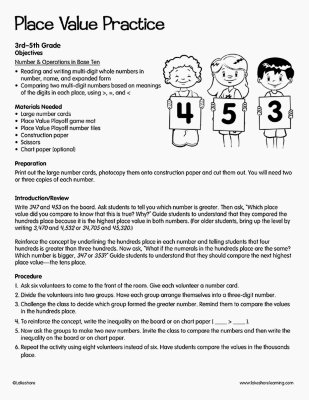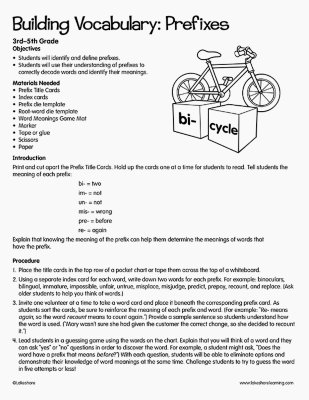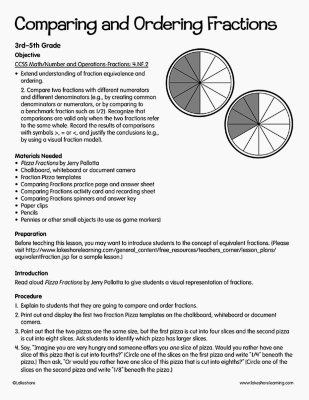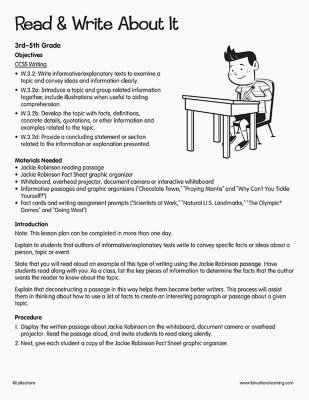Narrow by Grade
- Infant (0)
- Toddler (0)
- Preschool (0)
- Pre-K (0)
- Kindergarten (0)
- 1st (0)
- 2nd (0)
- 3rd (2)
- 4th (4)
- 5th (0)
- 6th & Up (0)
Grade
Narrow by Age
- 0-18m (0)
- 18-36m (4)
- 3 yrs. (0)
- 4 yrs. (7)
- 5 yrs. (7)
- 6 yrs. (2)
- 7 yrs. (4)
- 8 yrs. (4)
- 9 yrs. (4)
- 10 yrs. (1)
- 11 yrs. & Up (0)
Age 9 yrs.
0 results for "cbrooms" , here are results for "games"
Filters
Clear All
Place Value Practice
4th Grade
Objectives Number & Operations in Base Ten Reading and writing multi-digit whole numbers in number, name, and expanded form Comparing two multi-digit numbers based on meanings of the digits in each place, using >, =, and < Materials Needed Large number cards Place Value Playoff game mat Place Value Playoff number tiles Construction paper Scissors Chart paper (optional) Preparation: Print out the large number cards, photocopy them onto construction paper and cut them out. You will need two or three copies of each number. Introduction/Review Write 347 and 453 on the board. Ask students to tell you which number is greater. Then ask, “Which place value did you compare to know that this is true? Why?” Guide students to understand that they compared the hundreds place because it is the highest place value in both numbers. (For older students, bring up the level by writing 3,470 and 4,532 or 34,705 and 45,320.) Reinforce the concept by underlining the hundreds place in each number and telling students that four hundreds is greater than three hundreds. Now ask, “What if the numerals in the hundreds place are the same? Which number is bigger, 347 or 353?” Guide students to understand that they should compare the next highest place value—the tens place.
View Lesson PlanBuilding Vocabulary: Prefixes
3rd Grade - 4th Grade
Objectives Identifying and knowing the meaning of the most common prefixes and derivational suffixes Determining the meaning of the new word formed when a known affix is added to a known word Using common, grade-appropriate Greek and Latin affixes and roots as clues to the meaning of a word Materials Needed Prefix title cards Index cards Prefix die template Root-word die template Word meanings game mat Marker Tape or glue Scissors Paper Pocket chart or whiteboard Introduction Print and cut apart the prefix title cards. Hold up the cards one at a time for students to read. Tell students the meaning of each prefix: bi- = two im- = not un- = not mis- = wrong pre- = before re- = again Explain that knowing the meaning of the prefix can help them determine the meanings of words that have the prefix.
View Lesson PlanComparing and Ordering Fractions
4th Grade
Objective CCSS Math/Number and Operations-Fractions: 4.NF.2 Extend understanding of fraction equivalence and ordering. 2. Compare two fractions with different numerators and different denominators (e.g., by creating common denominators or numerators, or by comparing to a benchmark fraction such as 1/2). Recognize that comparisons are valid only when the two fractions refer to the same whole. Record the results of comparisons with symbols >, = or <, and justify the conclusions (e.g., by using a visual fraction model). Materials Needed Pizza Fractions by Jerry Pallotta Chalkboard, whiteboard or document camera Fraction Pizza templates Comparing Fractions practice page and answer sheet Comparing Fractions activity card and recording sheet Comparing Fractions spinners and answer key Paper clips Pencils Pennies or other small objects (to use as game markers) Preparation Before teaching this lesson, you may want to introduce students to the concept of equivalent fractions. (Please visit Equivalent Fraction Activities for a sample lesson.) Introduction Read aloud Pizza Fractions by Jerry Pallotta to give students a visual representation of fractions.
View Lesson PlanRead & Write About It
3rd Grade - 4th Grade
Objectives CCSS Writing W.3.2: Write informative/explanatory texts to examine a topic and convey ideas and information clearly. W.3.2a: Introduce a topic and group related information together; include illustrations when useful to aiding comprehension. W.3.2b: Develop the topic with facts, definitions, concrete details, quotations, or other information and examples related to the topic. W.3.2d: Provide a concluding statement or section related to the information or explanation presented. Materials Needed Jackie Robinson reading passage Jackie Robinson Fact Sheet graphic organizer Whiteboard, overhead projector, document camera or interactive whiteboard Informative passages and graphic organizers (“Chocolate Town,” “Praying Mantis” and “Why Can’t You Tickle Yourself?”) Fact cards and writing assignment prompts (“Scientists at Work,” “Natural U.S. Landmarks,” “The Olympic® Games” and “Going West”) Introduction Note: This lesson plan can be completed in more than one day. Explain to students that authors of informative/explanatory texts write to convey specific facts or ideas about a person, topic or event. State that you will read aloud an example of this type of writing using the Jackie Robinson passage. Have students read along with you. As a class, list the key pieces of information to determine the facts that the author wants the reader to know about the topic. Explain that deconstructing a passage in this way helps them become better writers. This process will assist them in thinking about how to use a list of facts to create an interesting paragraph or passage about a given topic.
View Lesson Plan


